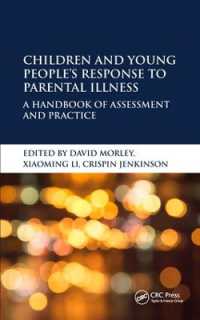Full Description
Femicide - the killing of women and girls - has gained increasing prominence on global and national agendas since the United Nations and the World Health Organisation, amongst others, started to respond to femicide as an issue of global concern. This edited collection explores the nature and extent of femicide, from intimate partner femicide to its connections with women's suicide, and the institutional failures associated with Indigenous women's deaths in the context of intimate partner violence. This collection contributes to progressing Sustainable Development Goal (SDG) 5.2.1: the elimination of all forms of violence against women and girls in public and in private, which sits within SDG5 focused on improving gender equality worldwide.
In extending recent work done by the editors on the measurement of women's deaths as a result of male violence, Femicide: Problems, Possibilities and Prevention considers how theory, research, activism, policy, and prevention in different contemporary environments impact on how femicide is defined, understood and prevented. The debates explored within this book pose particular challenges for practitioners in developing effective risk informed prevention.
Contents
Introduction: Defining, counting, preventing femicide; Kate Fitz-Gibbon and Sandra Walklate
Part One. Rendering femicide visible
Chapter 1. Counting femicides across the European Union; Cristina Fabre Rosell and Eneidia Bardho
Chapter 2. Change, intimacy, and relationships: Implications for measuring intimate and non-intimate femicide; Caroline Miles, Elizabeth A. Cook, and Merili Pullerits
Chapter 3. Counting women's deaths 'with' male violence and 'from' male violence: Lessons from the pandemic death counting practices; Kate Fitz-Gibbon and Sandra Walklate
Part Two. Rendering femicide knowable: reflections on practice
Chapter 4. Finding the victim's voice in fatality reviews; Negar Katirai
Chapter 5. Eliminating femicide: The role of expert domestic and family violence evidence in the coronial investigation process; Heather Douglas
Chapter 6. Domestic abuse-related death reviews in England and wales: Establishment, practices, and change; James Rowlands
Part Three. Rendering femicide preventable
Chapter 7. Coroners, femicide and the politics of preventability; Rebecca Scott Bray
Chapter 8. Intimate femicide, technology, and domestic and family violence; Bridget Harris
Chapter 9. Suicide and femicide: Rendering histories of violence visible in women's deaths from suicide; Kate Fitz-Gibbon and Stefani Vasil
Chapter 10. 'Boundary objects' and 'black boxes': Theory informed prevention for femicide; Sandra Walklate
Conclusion: Looking to the future, learning from the past; Kate Fitz-Gibbon and Sandra Walklate








